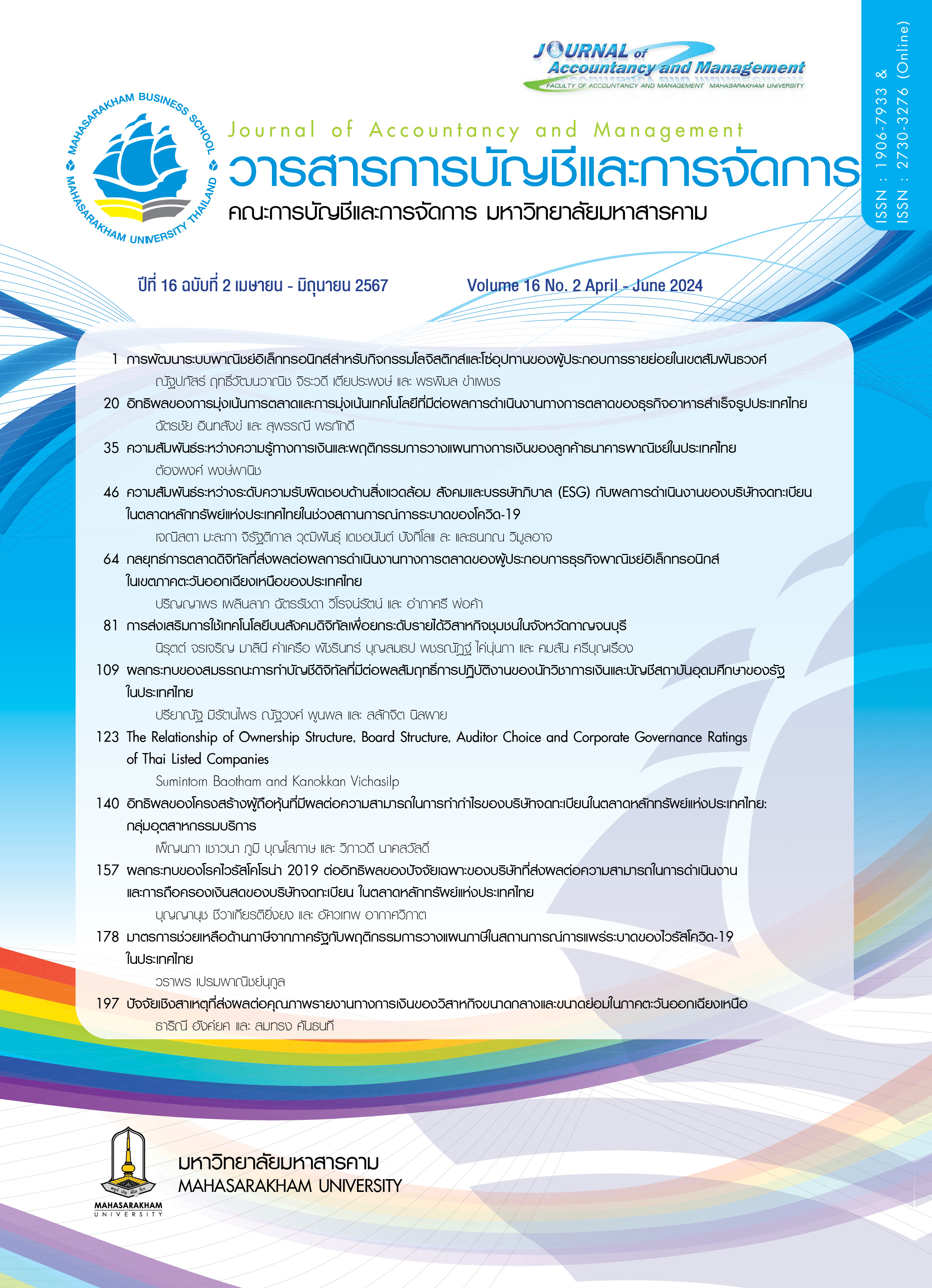ความสัมพันธ์ระหว่างระดับความรับผิดชอบด้านสิ่งแวดล้อม สังคมและ บรรษัทภิบาล (ESG) กับผลการดำเนินงานของบริษัทจดทะเบียนในตลาดหลักทรัพย์แห่งประเทศไทยในช่วงสถานการณ์การระบาดของโควิด-19
Main Article Content
บทคัดย่อ
การวิจัยนี้มีวัตถุประสงค์เพื่อศึกษาความสัมพันธ์ระหว่างระดับความรับผิดชอบด้านสิ่งแวดล้อม สังคม และบรรษัทภิบาล (ESG) กับผลการดำเนินงานของบริษัทจดทะเบียนในตลาดหลักทรัพย์แห่งประเทศไทย โดยใช้ตัววัด KLD ซึ่งเป็นข้อมูลในงบการเงินและรายงานประจำปีระหว่างปี พ.ศ. 2562-2565 เป็นระยะเวลา 4 ปี จำนวน 936 ตัวอย่าง สถิติที่ใช้ในการวิเคราะห์ข้อมูลได้แก่ สถิติเชิงพรรณนา การวิเคราะห์สหสัมพันธ์แบบพหุคูณและการวิเคราะห์การถดถอยแบบพหุคูณ ผลการศึกษา พบว่า ระดับความรับผิดชอบด้านชุมชนและ ด้านสินค้าและบริการมีวามสัมพันธ์เชิงบวกต่อมูลค่ากิจการ (Tobin's Q) ความสัมพันธ์เชิงบวกนี้บ่งชี้ว่าบริษัทที่มีระดับการมีส่วนร่วมของชุมชนและความรับผิดชอบต่อสินค้าและบริการในระดับที่สูงมีแนวโน้มที่จะมีมูลค่ากิจการที่สูงขึ้น นอกจากนี้ ผลของการวิจัยกลับพบว่าความรับผิดชอบด้านชุมชนและ ด้านสินค้าและบริการ มีความสัมพันธ์เชิงลบต่ออัตราผลตอบแทนของหุ้นสามัญ (Return) คำอธิบายหนึ่งที่เป็นไปได้ คือ บริษัทที่ให้ความสำคัญกับความรับผิดชอบด้าน ESG มักจะให้ความสำคัญกับความยั่งยืนและผลกระทบทางสังคมในระยะยาวมากกว่าผลกำไรทางการเงินในระยะสั้น บริษัทเหล่านี้มักจะลงทุนด้านทรัพยากรมากในด้านสิ่งแวดล้อม คำนึงถึงผลกระทบทางสังคม และการปฏิบัติตามหลักบรรษัทภิบาล ซึ่งอาจส่งผลกระทบต่อความสามารถการทำกำไรในระยะสั้นและส่งผลกระทบต่อผลตอบแทนที่เกิดจากหุ้นสามัญในเชิงลบ อย่างไรก็ตาม การศึกษานี้ไม่พบความสัมพันธ์อย่างมีนัยสำคัญทางสถิติระหว่าง ESG กับอัตราผลตอบแทนสินทรัพย์รวม (ROA) และอัตราผลตอบแทนส่วนของผู้ถือหุ้น (ROE)
Downloads
Article Details

อนุญาตภายใต้เงื่อนไข Creative Commons Attribution-NonCommercial-NoDerivatives 4.0 International License.
บทความที่ได้รับการตีพิมพ์เป็นลิขสิทธิ์ของวารสารการบัญชีและการจัดการ
ข้อความที่ปรากฏในบทความแต่ละเรื่องในวารสารวิชาการเล่มนี้เป็นความคิดเห็นส่วนตัวของผู้เขียนแต่ละท่านไม่เกี่ยวข้องกับมหาวิทยาลัยมหาสารคาม และคณาจารย์ท่านอื่นๆในมหาวิทยาลัยฯ แต่อย่างใด ความรับผิดชอบองค์ประกอบทั้งหมดของบทความแต่ละเรื่องเป็นของผู้เขียนแต่ละท่าน หากมีความผิดพลาดใดๆ ผู้เขียนแต่ละท่านจะรับผิดชอบบทความของตนเองแต่ผู้เดียว
เอกสารอ้างอิง
กนกพร รัตนอำพล ธารินี พงศ์สุพัฒน์ และ อภิชาตพงศ์สุพัฒน์. (2564). ปัจจัยที่ส่งผลต่อราคาหลักทรัพย์กลุ่มหุ้นยั่งยืนในตลาดหลักทรัพย์แห่งประเทศไทย. Journal of Buddhist Education and Research, 7(3), 62-72.
จ๊อบส์ดีบี ประเทศไทย. (2564). แผนกวิจัยและพัฒนาสำคัญอย่างไร องค์กรไหนที่ควรมี. ค้นเมื่อวันที่ 16 พฤษภาคม 2566, จาก https://th.jobsdb.com/th-th/articles/research-and-development/.
ณัฐกานต์ วุฒิสมานันท์. (2561). การศึกษาความสัมพันธ์ระหว่างระดับความรับผิดชอบด้านสิ่งแวดล้อม สังคม และบรรษัทภิบาล(ESG) กับผลตอบแทนหลักทรัพย์ กรณีศึกษาบริษัทในกลุ่ม ESG100. ปทุมธานี : มหาวิทยาลัยธรรมศาสตร์.
ตลาดหลักทรัพย์แห่งประเทศไทย. (2560). การเปิดเผยข้อมูลและรายงานด้านความยั่งยืน Sustainability Disclosure and Reporting. ค้นเมื่อวันที่ 2 กุมภาพันธ์ 2566, จาก https://setsustainability.com/page/disclosure.
ตลาดหลักทรัพย์แห่งประเทศไทย.(2566). ตลาดหลักทรัพย์ฯ ส่งเสริมระบบนิเวศด้านความยั่งยืนให้บริการ ESG Data Platform สำหรับบริษัทมหาชนจำกัด. ค้นเมื่อวันที่ 30 มีนาคม 2566, จาก https://www.set.or.th/th/about/setsource/news-release/article/96-esg-data-platform-.
ไตรรงค์ สวัสดิกุล และคณะ. (2565). ผลกระทบของคะแนนสิ่งแวดล้อม สังคม และธรรมาภิบาลต่อผลลัพธ์ขององค์กรของบริษัทจดทะเบียนจาก IMT-GT. การประชุมงานสัมมนาวิชาการในระดับภูมิภาคประจำปี 2565. 1 กรกฎาคม 2565. ณ โรงแรมบายาสิตา มหาวิทยาลัยขอนแก่น จังหวัดขอนแก่น.
ธนิสร ศิลามณีรัตน์. (2562). การศึกษาผลการดำเนินงานของกลุ่มหลักทรัพย์หุ้นยั่งยืนที่ได้รับการคัดเลือกโดยตลาดหลักทรัพย์แห่งประเทศไทย. ปทุมธานี : มหาวิทยาลัยธรรมศาสตร์.
ธีรพร ทองขะโชค และ อาคม ใจแก้ว. (2556). ปัจจัยที่มีอิทธิพลต่อความรับผิดชอบต่อสังคมของบริษัทจดทะเบียน ในตลาดหลักทรัพย์แห่งประเทศไทย. Songklanakarin Journal of Management Sciences, 30(1), 23-51.
ธัญอร ยอดอุดม และ มุทราชัย สุทธิพันธ์. (2563). อิทธิพลของการเปิดเผยข้อมูล ESG ต่อมูลค่ากิจการในประเทศไทย เพื่อศึกษาขอบเขตและระดับของสิ่งแวดล้อม. Journal of Finance and Banking Review, 5(3),108-114.
นพพร แพทย์รัตน์. (2564). ความสัมพันธ์ระหว่างการเปิดเผยข้อมูลการลงทุนเพื่อสังคมกับมูลค่าองค์กรตามราคาตลาด.วารสารวิชาการ มหาวิทยาลัยหอการค้าไทย มนุษยศาสตร์และสังคมศาสตร์, 41(3), 74-87.
นฤมล ตั้งหมั่นทวีวัฒน์ และ วินัย หอมสมบัติ, (2559). การสร้างมูลค่าเพิ่มทางเศรษฐศาสตร์ผ่านคุณค่าตราผลิตภัณฑ์จากโครงการความรับผิดชอบต่อสังคม. วารสารสังคมศาสตร์ มหาวิทยาลัยศรีนครินทรวิโรฒ, 19(1), 84-101.
นิตยา โยธาจันทร์ ศศิวิมล มีอำพล และ ไพบูลย์ ผจงวงศ์. (2563). ความสัมพันธ์ระหว่างการเปิดเผยข้อมูลรายงานความยั่งยืนกับผลการดำเนินงานของบริษัทในกลุ่ม ESG100. วารสารบรรณศาสตร์ มศว., 13(2), 12-26.
เบญจรัตน์ ศรีสุรภานนท์. (2560). การศึกษาความสัมพันธ์ระหว่างระดับความรับผิดชอบต่อสังคมกับมูลค่าของกิจการและการถูกคัดเข้ากลุ่มหลักทรัพย์ ESG100 สำหรับบริษัทจดทะเบียนในกลุ่มดัชนี SET100. ปทุมธานี : มหาวิทยาลัยธรรมศาสตร์.
ปาณมน จันทบุตร. (2565). ผลกระทบของความรับผิดชอบด้านสิ่งแวดล้อม สังคม และบรรษัทภิบาลต่อความเสี่ยงจากการล้มเหลวทางการเงินของกิจการที่จดทะเบียนในตลาดหลักทรัพย์แห่งประเทศไทย บริบทของวิกฤตเศรษฐกิจ.วารสารวิชาชีพบัญชี, 18(59), 26-52.
พร้อมพร ภูวดิน. (2561). ความสัมพันธ์ระหว่างการเปิดเผยข้อมูลเกี่ยวกับความยั่งยืนของบริษัทและผลการด าเนินงานทางการเงิน:กรณีศึกษาบริษัทจดทะเบียนในประเทศไทย. วารสารวิทยาลัยดุสิตธานี, 12(3), 429-444.
พิมพ์โพยม สุดเจริญ. (2564). การศึกษาผลกระทบของระดับความรับผิดชอบด้านสิ่งแวดล้อม สังคมและบรรษัทภิบาล (ESG) ต่อผลการดําเนินงานผ่านความเสี่ยงของบริษัทจดทะเบียนในตลาดหลักทรัพย์แห่งประเทศไทย. ปทุมธานี : มหาวิทยาลัยธรรมศาสตร์.
พิมล เลิศทรัพย์อนันต์ และ ปริญญา มากลิ่น. (2565). อิทธิพลของการบริหารจัดการความยั่งยืนด้านสิ่งแวดล้อม สังคม และการกำกับดูแลกิจการต่อความยั่งยืนทางการเงินของบริษัทจดทะเบียนในตลาดหลักทรัพย์แห่งประเทศไทย. Journal of Business Administration and Languagesม 10(2), 101-122.
พิศิษฐ์ อัศวบรรจงผล. (2562). ความสัมพันธ์ระหว่างการรายงานความยั่งยืนกับอัตราส่วน Tobin’s Q ของบริษัทจดทะเบียนในตลาดหลักทรัพย์แห่งประเทศไทยในกลุ่มดัชนี SET 100. กรุงเทพฯ : มหาวิทยาลัยกรุงเทพ.
ภัณฑิรา มณีไพรัตน์. (2562). อิทธิพลระหว่างการเปิดเผยข้อมูลความรับผิดชอบต่อสังคมกับผลตอบแทนผู้ถือหุ้น : กรณีศึกษาบริษัทที่ได้รับการจัดอันดับธุรกิจด้านการพัฒนาความยั่งยืน. วิทยานิพนธ์ปริญญาบัญชีมหาบัณฑิต มหาวิทยาลัยสงขลานครินทร์.
ภัสสิริ ศรสงคราม. (2560). การศึกษาความสัมพันธ์ระหว่างความรับผิดชอบด้านสิ่งแวดล้อม สังคม และบรรษัทภิบาลขององค์กร (ESG) กับมูลค่ากิจการ (TOBIN’S Q) ในหมวดธุรกิจพลังงานที่จดทะเบียนอยู่ในตลาดหลักทรัพย์แห่งประเทศไทย. ปทุมธานี : มหาวิทยาลัยธรรมศาสตร์.
วรพรรณ เผ่าสิริพัลลภ. (2564). การศึกษาความสัมพันธ์ระหว่างระดับความรับผิดชอบด้านสิ่งแวดล้อมสังคม และบรรษัทภิบาล (ESG) ของบริษัท และการถูกคัดเลือกเข้าดัชนี SETTHSI ต่อแนวโน้มการทุจริต. ปทุมธานี : มหาวิทยาลัยธรรมศาสตร์.
ศิรินันท์ ปิยะอัษฎารัตน์. (2563). ความสัมพันธ์ระหว่าง ESG Performance กับประสิทธิภาพทางการเงินในกลุ่มบริษัทอุตสาหกรรมที่อ่อนไหว (Sensitive Industries) กรณีศึกษาในกลุ่มสมาชิกสหภาพยุโรป. นครปฐม : มหาวิทยาลัยมหิดล.
อัญชลี พิพัฒนเสริญ และ ศิลปพร ศรีจั่นเพชร. (2560). การตอบสนองของตลาดหลักทรัพย์แห่งประเทศไทยกับธรรมาภิบาล คุณภาพกำไร และผู้สอบบัญชี. วารสารวิชาชีพบัญชี, 13(40), 22-31.
อัญชิสา เติมวาณิช. (2558). ความสัมพันธ์ระหว่างระดับของความรับผิดชอบต่อสังคมของบริษัทและอัตราผลตอบแทนจากการลงทุนในหุ้น: กรณีศึกษาบริษัทในกลุ่ม ESG100. ปทุมธานี : มหาวิทยาลัยธรรมศาสตร์.
Barnard, C. (1938), The Functions of the Executive. Cambridge, MA. : Harvard University Press.
Chen, Z., & Xie, G., (2022).ESG disclosure and financial performance: Moderating role of ESG investors. International Review of Financial Analysis, 83(4), 102291.
Crisóstomo, V. L., Freire, F. S. & Vasconcellos, F. C. (2011, June). Corporate social responsibility Firm Value and financial performance in Brazil. Social Responsibility Journal, 7(2), 295-309.
David, C., Chan, K., Cheng, Louis, T. W., & Wang, X. (2021). The role of ESG performance during times of financial crisis: Evidence from COVID-19 in China. Finance Research Letters, Elsevier, 38(C), 101716.
Fatemi, A., Glaum, M., & Kaiser, S. (2018). ESG performance and firm value: The moder-ating role of disclosure Special Issue on Corporate Social Responsibility and Ethics in Financial Markets. Global Finance Journal, 38, 45–64.
Freeman, R. E. (1984). Strategic management: A stakeholder approach. Boston : Pitman.
Gray, E. R., & Balmer, J. T., (1998). Managing Corporate Image and Corporate Reputation. Pergamon Press of Elsevier Science, 31(5), 695-702.
Gujarati, D. N., Bernier, B., & Bernier, B. (2004). Econométrie. Brussels : De Boeck.
Jaggi, B., & Freeman, M. (1992). An examination of the impact of pollution performance on economic and market performance: Pulp and paper firms. Journal of Business Finance and Accounting, 19(5), 697-713.
Jang, S. S., Ko, H., Chung, Y., & Woo, C. (2019). CSR, social ties and firm performance. Corporate Governance: The International Journal of Business in Society, 19(6), 1310-1323.
Kennedy, P. (1992). Violating Assumption Five: Multicollinearity. Guide to Econometrics, 1st ed.; Kennedy, P., Ed, 192-202.
Karishma, K., & Thaker, N. (2019). ESG and corporate financial performance: a panel study of Indian companies. The IUP Journal of corporate governance, 18(1), 44-59.
Lawrence, A. T., & Weber, J. (2010). Business and society: Stakeholders, ethics, public policy. Boston : McGraw-Hill Irwin.
Quintiliani, A. (2022). ESG and Firm Value. Accounting and Finance Research, 11(4), 37-47.
Ramic, H. (2019). Relationship between ESG performance and financial performance of companies: an overview of the issue. Thesis for Master of Science in Accounting, Control and Finance.
Shiu, Y.-M., & Yang, S. L. (2017). Does Engagement in Corporate Social Responsibility Provide Strategic Insurance-like Effects? Strategic Management Journal, 38(2), 455-470.
Suttipun, M. (2023). ESG Performance and Corporate Financial Risk of the Alternative Capital Market in Thailand. Cogent Business & Management, 10(1), 2168290.
Van Hoang, T., Segbotangnib, E., & Lahiani, A., (2021). ESG Performance and COVID-19 Pandemic: An Empirical Analysis of European Listed Firms. Social Science Research Network (SSRN), 28, 1-29.
Yoo, S., & Managi, S. (2022). Disclosure or action: Evaluating ESG behavior towards financial performance. Finance Research Letters, 44(C).


